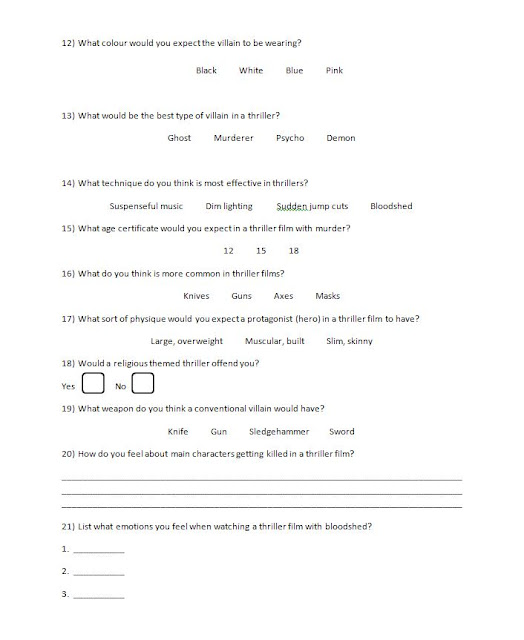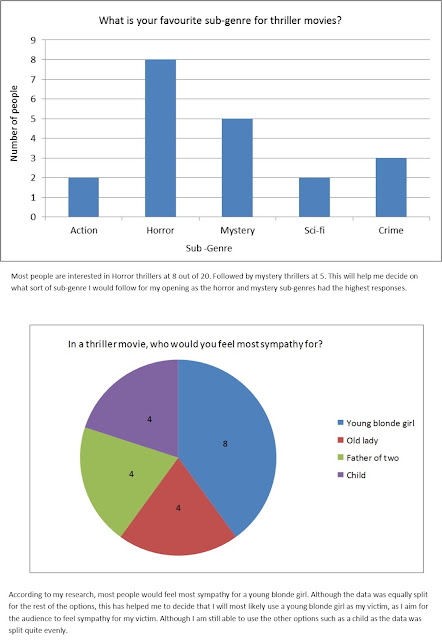Secondary research into existing films is very important when it came to the idea of target audiences and choosing one. Doing this research allowed me to understand the demographics of people who watch thriller films and what appealed to which audiences. This is vital as many key decisions had to be made in terms of mise en scene, conventions, characters and themes. Analysing audience responses properly and understanding what different people want in thrillers helped us make these decisions and to make the appropriate decisions.
The target audience of thriller films:
With my secondary research into thrillers, I believe that the target audience that they appeal to are generally of the following:
Age: 15-40
Gender: Unisex
Ethnicity: No specific ethnicity. Universal appeal.
Occupation: Students, usually in higher education and people in employment.
Hobbies and interests: Sports, reading, playing video games and going to the cinema to watch films regularly.
I believe that from thriller films the target audience enjoy the thrill and excitement when watching thriller films. I had learned that violence and murder seemed to appeal to the younger generation more as they were more interested in themes such as death. The target audience seemed to also enjoy watching horror thriller films as they enjoyed the feeling of being scared and the emotions it makes them feel.
Furthermore, the emotions I believe the audience are likely to experience are both psychological and physiological. When are there scenes in thriller films that involve the protagonists or antagonists, they can evoke emotions such as fear or happiness, depending on the character and what they are doing. For example if the protagonist is in trouble and something bad is about to happen to them, the audience may experience the psychological emotions of fear, sadness or anxiety. But they will also experience the physiological effects of sweating and an elevated heartbeat. This can also happen when seeing dead bodies or an antagonist attempting or going through with murder. Another feature I found in thriller films which was very effective in evoking emotions was jump scares. If there is a scene where a figure would appear suddenly and unexpectedly, the audience would enjoy this as they find the appeal in being frightened and the rapid elevating of their heartbeat due to excitement.
This was useful research as it meant that for my thriller I had to consider what conventions and themes to follow to appeal to my target audience. Also I had to follow the BBFC guidelines to make sure there was not too much violence, or blood to make it more than a 15 rated film, my secondary research into the BBFC aided this greatly. I had to consider the genre and whether it attracted the audience I wanted of young adults aged 15 and above, who enjoy going to the cinema regularly and watching thriller films.
I carried out a questionnaire because I needed direct information, feedback and opinions from my potential target audience. The importance of my questionnaire is that it only gave me direct responses from my target audience, this was extremely useful as I could assess the answers to them and implement the necessary things to my thriller opening. Those answering the questions were given specific choices which also helped a lot, and different questions were given for initial ideas. As a group we then identified ideas and scrutinised each others questions, making sure our questionnaire was as useful to its full extent.
Key questions asked to help make key decisions
Some examples of the key questions we asked our audience
Multiple questions
What kind of character would you want a thriller film to be centered around?
Victim Murderer Anti-Hero Detective Hero
What technique do you
think is most effective in thrillers?
Suspenseful
music Dim lighting Sudden jump cuts Bloodshed
Open ended
How do you feel about main
characters getting killed in a thriller film?
What excites you most
about a thriller film and why?
These questions were very specific to my thriller idea and helped make the final decisions as the audience feedback and influence was vital for audience appeal.
Quotes of answers from our open ended questions and how it helped make key decisions
How do you feel about main characters getting killed in a thriller film?
"This would be very effective in a thriller film as it is a very unexpected thing to happen. It would scare the audience as well as confuse them as it is not conventional for the main character to die in a film." - Shane, aged 17
What excites you most about a thriller film and why?
"The suspense and usually violence is what excites me most in a thriller film. Probably because of the physiological effect a thriller film has on me and that violence isn't very common for me so it's exciting" - Alice, aged 21
These questions helped me make key decisions such has presenting the apparent death of a main character as the girl that follows the antagonist. This was because I was sure I could appeal to the audience due to the results from my questionnaire and therefore had to make the key decision in the narrative of my opening. As well as this the other open ended question helped us make the decisions to add elements of suspense and violence to excite the audience.



Results of key graphs


Overall the primary research was important because the questionnaire was the only part of our research that we were directly involved in and could get direct feedback and opinions from a potential target audience. It helped me address my target audience as I could apply their feedback to my thriller to make it appealing to my target audience, as the questionnaire was given to the age range of the people we considered to be the target audience for our thriller.
Audience feedback
After creating a rough cut of my thriller opening,a focus group was held to get the direct opinions and feedback from an audience which mostly consisted of AS and A2 Media, drama and Film studies students. This would be a lot more useful as their feedback would be a lot more technical and accurate to minor flaws in my thriller opening. below is some of the constructive criticism I received.
Focus group images
Positive feedback from Sophie, aged 18
After receiving this feedback I felt as if I had attracted my audience properly through the use of mise en scene to build character representation.
Positive feedback from Laura, aged 16
This feedback made me feel glad that I used the sound effectively during the editing process.
I also received negative feedback from Sally, aged 15
This feedback made me understand that I had to alter the typography slightly by making it bolder and therefore clearer to read.
Finally I also received a form of negative feedback from Amanda, aged 17
This criticism made me realise that we should have taken into consideration the antagonist's clothing before filming so he could have had a more intimidating affect on the audience.


Excellent work here on how you addressed and attracted your target audience. Initial secondary research has clearly helped you make decisions on who your audience would be.
ReplyDeleteThe importance of audience feedback is addressed as you display your questionnaire and identify key questions and illustrate the results you received which helped you with specific choices and outcomes.
Finally, post-production (rough cut) focus group feedback allowed you to assess, and make final changes to attract your audience.